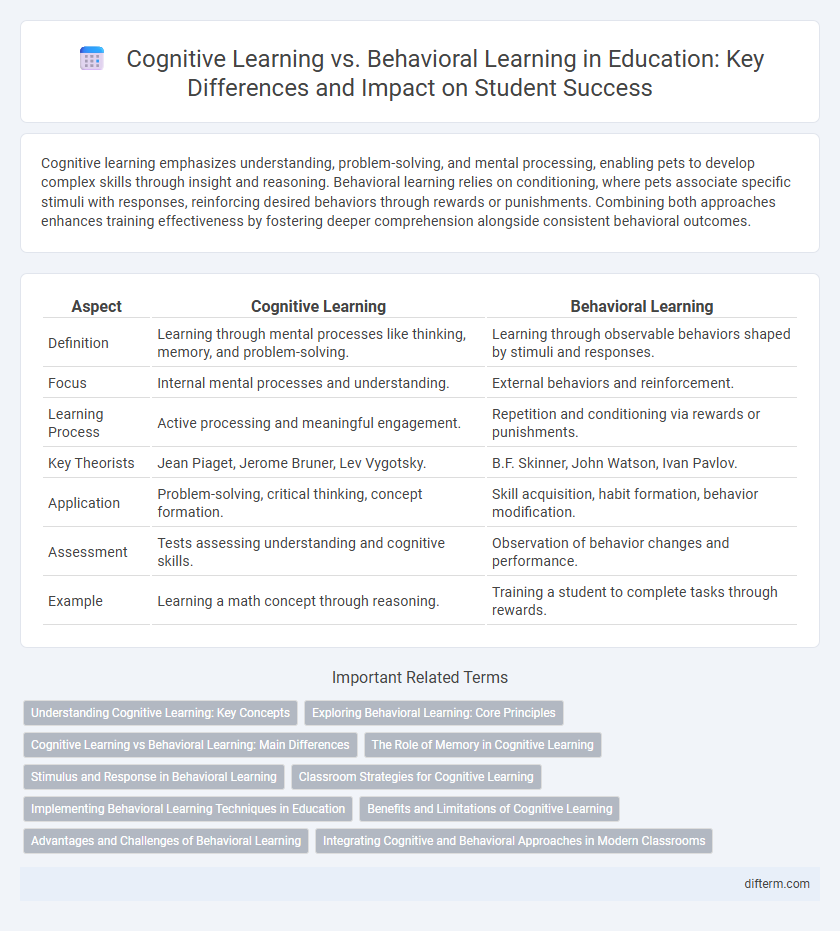Cognitive learning emphasizes understanding, problem-solving, and mental processing, enabling pets to develop complex skills through insight and reasoning. Behavioral learning relies on conditioning, where pets associate specific stimuli with responses, reinforcing desired behaviors through rewards or punishments. Combining both approaches enhances training effectiveness by fostering deeper comprehension alongside consistent behavioral outcomes.
Table of Comparison
| Aspect | Cognitive Learning | Behavioral Learning |
|---|---|---|
| Definition | Learning through mental processes like thinking, memory, and problem-solving. | Learning through observable behaviors shaped by stimuli and responses. |
| Focus | Internal mental processes and understanding. | External behaviors and reinforcement. |
| Learning Process | Active processing and meaningful engagement. | Repetition and conditioning via rewards or punishments. |
| Key Theorists | Jean Piaget, Jerome Bruner, Lev Vygotsky. | B.F. Skinner, John Watson, Ivan Pavlov. |
| Application | Problem-solving, critical thinking, concept formation. | Skill acquisition, habit formation, behavior modification. |
| Assessment | Tests assessing understanding and cognitive skills. | Observation of behavior changes and performance. |
| Example | Learning a math concept through reasoning. | Training a student to complete tasks through rewards. |
Understanding Cognitive Learning: Key Concepts
Cognitive learning emphasizes the internal processes of acquiring knowledge, such as perception, memory, and problem-solving, contrasting with behavioral learning which focuses on observable responses and reinforcement. Key concepts in cognitive learning include information processing, schema development, and metacognition, which enable learners to actively construct meaning and apply critical thinking. This approach fosters deeper understanding and adaptability, essential for complex problem-solving and lifelong learning.
Exploring Behavioral Learning: Core Principles
Behavioral learning centers on observable behaviors shaped by stimuli and reinforcement, emphasizing repetition and practice to instill new skills. Core principles include classical conditioning, where associations form between stimuli, and operant conditioning, which relies on rewards and punishments to influence behavior. This approach proves effective in habit formation, skill acquisition, and environments requiring clear, measurable learning outcomes.
Cognitive Learning vs Behavioral Learning: Main Differences
Cognitive learning emphasizes internal mental processes such as thinking, memory, and problem-solving, while behavioral learning focuses on observable behaviors shaped by stimuli and responses. Key differences include cognitive learning's reliance on understanding and insight versus behavioral learning's dependence on reinforcement and conditioning. This distinction impacts instructional strategies, with cognitive approaches promoting active engagement and behavioral methods emphasizing practice and repetition.
The Role of Memory in Cognitive Learning
Memory plays a crucial role in cognitive learning by enabling the storage, retrieval, and application of information, which supports problem-solving and critical thinking skills. Unlike behavioral learning that emphasizes observable behaviors and external reinforcement, cognitive learning involves internal mental processes such as encoding and consolidation. Effective cognitive learning strategies leverage working memory and long-term memory to foster deeper understanding and knowledge retention.
Stimulus and Response in Behavioral Learning
Behavioral learning centers on the relationship between stimulus and response, where external stimuli trigger observable behavioral changes through reinforcement or punishment. In contrast, cognitive learning emphasizes internal mental processes such as thinking, memory, and problem-solving rather than direct stimulus-response associations. Understanding stimulus-response mechanisms in behavioral learning helps educators design effective interventions that modify student behavior through consistent feedback.
Classroom Strategies for Cognitive Learning
Classroom strategies for cognitive learning emphasize active engagement through problem-solving, critical thinking, and metacognitive reflection, fostering deeper understanding and knowledge retention. Techniques like questioning, concept mapping, and collaborative discussions help students process information meaningfully rather than relying on rote memorization. Incorporating multimedia resources and real-world applications enhances cognitive connections and promotes long-term learning outcomes.
Implementing Behavioral Learning Techniques in Education
Implementing behavioral learning techniques in education involves applying reinforcement principles to shape student behavior and promote skill acquisition through repetition and positive feedback. This approach emphasizes observable changes in student actions, using methods like rewards, punishments, and systematic drills to enhance learning outcomes. Effective behavioral strategies increase classroom engagement, improve discipline, and support mastery of foundational skills by linking behavior with consequences.
Benefits and Limitations of Cognitive Learning
Cognitive learning enhances critical thinking, problem-solving skills, and the ability to process and apply information in diverse contexts, making it effective for deep understanding and long-term knowledge retention. However, cognitive learning can be time-consuming and requires higher mental effort, which may lead to learner frustration or difficulty for students with limited prior knowledge. While it promotes active engagement and self-regulation, cognitive learning may be less effective for rote memorization tasks compared to behavioral learning methods.
Advantages and Challenges of Behavioral Learning
Behavioral learning emphasizes observable changes in behavior through reinforcement and repetition, facilitating measurable progress in skill acquisition and habit formation. This approach offers advantages such as structured learning environments and clear performance feedback, promoting consistent practice and mastery of specific tasks. Challenges include limited focus on internal cognitive processes and creativity, potentially leading to rote memorization and lack of critical thinking development.
Integrating Cognitive and Behavioral Approaches in Modern Classrooms
Integrating cognitive and behavioral learning approaches in modern classrooms enhances student engagement and knowledge retention by combining mental processes with observable actions. Cognitive strategies promote critical thinking and problem-solving skills while behavioral techniques reinforce positive habits through consistent feedback and rewards. This holistic approach fosters a balanced learning environment, adapting to diverse student needs and improving overall academic performance.
cognitive learning vs behavioral learning Infographic

 difterm.com
difterm.com